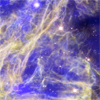CXC Home | Search | Help | Image Use Policy | Latest Images | Privacy | Accessibility | Glossary | Q&A
Tour of N49
Quicktime MPEG
This beautiful image shows N49, which is the aftermath of a supernova explosion in the Large Magellanic Cloud. Optical data from Hubble shows bright filaments where the shockwave generated by the supernova is interacting with the densest regions in nearby clouds of cool molecular gas. A new long observation from Chandra, equaling over 30 hours of observing time, reveals evidence for a bullet-shaped object that is being blown out of the debris field which is left over from an exploded star. This bullet, which is traveling some 5 million miles per hour, was ejected when the supernova went off and is rich in Silicon, Sulfur and Neon. The detection of this bullet shows that the explosion that destroyed the star was highly asymmetric , and gives clues to how some stars explode.
[Runtime: 0:55]
Quicktime MPEG
This beautiful image shows N49, which is the aftermath of a supernova explosion in the Large Magellanic Cloud. Optical data from Hubble shows bright filaments where the shockwave generated by the supernova is interacting with the densest regions in nearby clouds of cool molecular gas. A new long observation from Chandra, equaling over 30 hours of observing time, reveals evidence for a bullet-shaped object that is being blown out of the debris field which is left over from an exploded star. This bullet, which is traveling some 5 million miles per hour, was ejected when the supernova went off and is rich in Silicon, Sulfur and Neon. The detection of this bullet shows that the explosion that destroyed the star was highly asymmetric , and gives clues to how some stars explode.
[Runtime: 0:55]
(Credits: X-ray: (NASA/CXC/Penn State/S.Park et al.); Optical: NASA/STScI/UIUC/Y.H.Chu & R.Williams et al)
Return to N49 (May 24, 2010)



